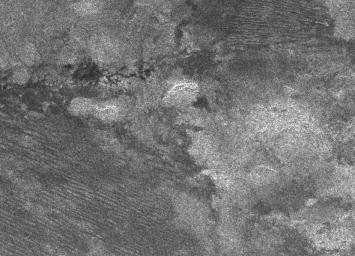
|
Diverse Geology
- Click the image above for a larger view
- Full-Res JPEG (829 x 598) (142.4 kB)
- Full-Res TIFF (829 x 598) (496.5 kB)
Caption:
The geologic diversity of Titan's surface is well illustrated by this synthetic aperture radar image, obtained on Oct. 28, 2005, during the Cassini spacecraft's ninth Titan fly-by and fourth radar pass.
The bottom left and top right parts of the image show a series of parallel features resembling those discovered during the second radar pass. Called "cat scratches," these may be dunes of water ice or hydrocarbon particles. The brighter area on the bottom right is thought to be rougher and possibly higher in elevation than the darker areas. Above the center of the image are dark, narrow winding channels carved by, and possibly still containing, liquids.
This image is about 300 kilometers (186 miles) by 250 kilometers (155 miles). It is located 10 degrees south latitude and 292 degrees west longitude.
Background Info:
The Cassini-Huygens mission is a cooperative project of NASA, the European Space Agency and the Italian Space Agency. The Jet Propulsion Laboratory, a division of the California Institute of Technology in Pasadena, manages the mission for NASA's Science Mission Directorate, Washington, D.C. The Cassini orbiter was designed, developed and assembled at JPL. The radar instrument team is based at JPL, working with team members from the United States and several European countries.
For more information about the Cassini-Huygens mission visit http://saturn.jpl.nasa.gov .
Cataloging Keywords:
| Name | Value | Additional Values |
|---|---|---|
| Target | Titan | |
| System | Saturn | |
| Target Type | Satellite | |
| Mission | Cassini-Huygens | |
| Instrument Host | Cassini Orbiter | |
| Host Type | Orbiter | |
| Instrument | Radar Mapper | |
| Detector | ||
| Extra Keywords | Dune, Grayscale, Radar, Water | |
| Acquisition Date | ||
| Release Date | 2005-11-01 | |
| Date in Caption | 2005-10-28 | |
| Image Credit | NASA/JPL-Caltech/ASI | |
| Source | photojournal.jpl.nasa.gov/catalog/PIA03568 | |
| Identifier | PIA03568 | |
